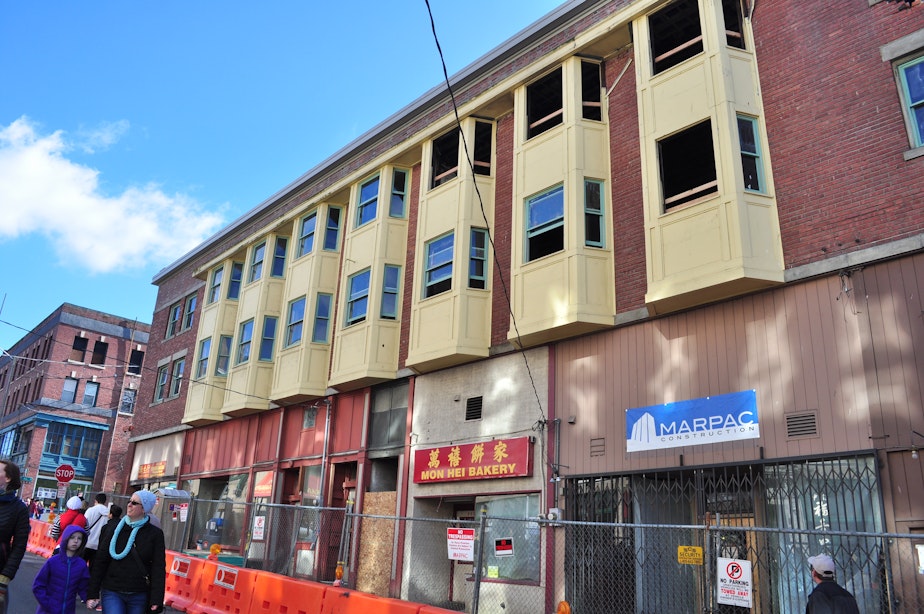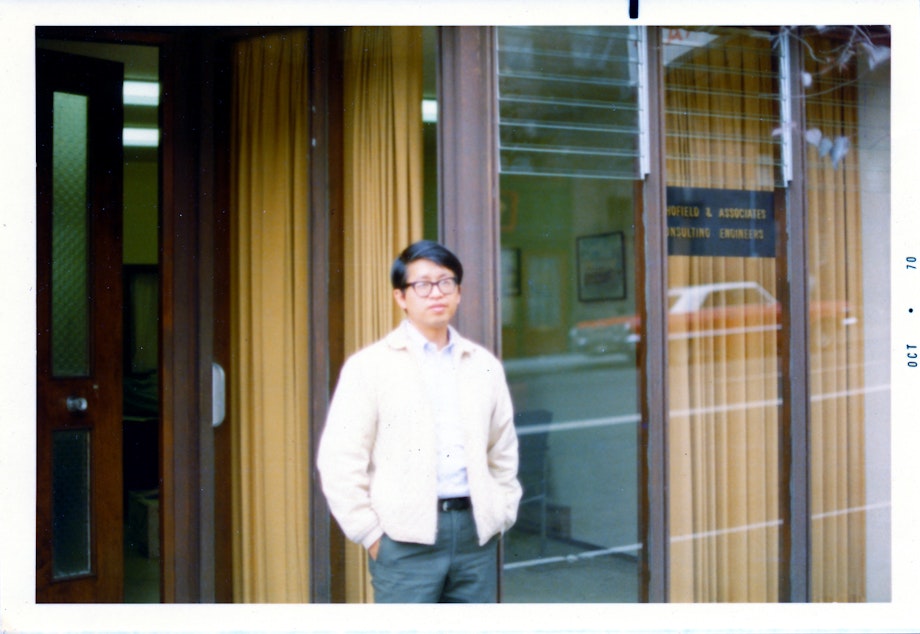How many Seattle buildings would be doomed in a big earthquake?
Tanya Woo of Seattle discovered recently that relationships with people can blossom after they've died.
Going through her late father’s files, she found his hopes, dreams, and plans – literal, architectural plans – for the Louisa Hotel on South King Street, which he bought for a song, $160,000 to be precise, in 1963.
The Louisa Hotel is also where he died of a heart attack some 20 years ago.
Now Woo is following her late father’s legacy and reviving the building, which was heavily damaged by fire in 2013.
When it opens, the building will house retail, restaurants, and 84 one-bedroom and studio apartments for seniors and middle-income residents. It will also be among the safer places in Seattle's Chinatown-International District in the event of an earthquake.
And because of that distinction, the building will serve as an example of solution to a development catch-22 that has plagued the historic neighborhood for decades.
Sponsored
Vulnerable buildings
Chinatown ID is filled with brick buildings built in the 1910s and 1920s that are vulnerable to earthquakes. Tearing them down isn't an option, however, because of their historic significance.
Fixing them would be costly, and many of these buildings are owned by families that bought them outright and are reluctant to assume debt to fix them.
It's not just that the buildings are falling into further disrepair. Seattle continues to enforce more rigid building safety regulations, adding to the upgrades these families would have to cover.
Sponsored
KUOW is looking into this issue because of a question from our recent Disaster Night event. Listener Merritt Green from Columbia City asked, “What percentage of building in Seattle are likely to be seriously damaged in a major earthquake?”
I invited Green to Chinatown ID to see how the answer to the question plays out on the ground. We met UW civil engineering professor, Jeff Berman, and Paul Mar and MaryKate Ryan, who are representatives from the Seattle Chinatown International District Preservation and Development Authority (SCIDpda).
Finding out how many buildings are doomed depends on factors including origin, strength and depth of a quake, Berman said. An earthquake caused by the Seattle Fault – which runs roughly the route of I-90 across Seattle and Mercer Island – would cause very intense shaking lasting a short time.
“It'd be like the worst roller coaster you've been on,” Berman said.
In much of King County, the shaking would be strong enough to fell chimneys, jostle heavy furniture and heave some buildings off their foundations, according to estimates in the Washington State Earthquake Hazards Scenario Catalog computed using Federal Emergency Management Agency’s Hazards United States, or HAZUS, software.
Sponsored
According to the estimates, a magnitude 7.2 Seattle Fault earthquake would damage 357,789 buildings in King County.
(Showing our math:
There are 614,300 buildings in King County, according to the county assessor.
If 357,789 buildings would be compromised, that's 58 percent of buildings in the county.)
More than 21,000 buildings, or roughly 6 percent, would suffer the most extensive damage, and thousands are expected to collapse entirely.
An earthquake originating from tectonic plates sliding under each other off the Pacific Coast, known as the Cascadia subduction zone, might roil the earth under our feet for several minutes. It would feel more like being on a boat, Berman said.
More than 130,000 buildings would be damaged in King County, according to HAZUS estimates.
In any event, Chinatown ID would be in a tough spot. The neighborhood's century-old brick structures were constructed before modern seismic codes. Known as unreinforced masonry, they are among the most hazardous in the event of an earthquake.
“We would expect a lot of buildings around here to need extensive repair resulting in displaced people,” Berman said. “Some of the older buildings, we would expect to see collapse.”
Sponsored
Vulnerable people
Numbers alone don’t tell the full story.
The people most vulnerable to disaster rely on buildings that are also vulnerable.
This August, the University of South Carolina assessed neighborhoods across Seattle for how easily their residents would be able to bounce back from disaster. Their index of vulnerability includes data on race, class and age, as well as English proficiency, and health insurance coverage.
The researchers rated Chinatown ID as highly vulnerable to hazards, such as earthquakes.
Sponsored
Roughly one third of Seattle’s risky, old brick buildings are in areas people are most likely to be affected by disaster and least able to recover, according to KUOW’s analysis of data from the city of Seattle and the University of South Carolina.
“The risk of not upgrading these buildings is that with some (earthquake) event happening in the future, we may lose these buildings, and worse off, we may lose human life,” said Paul Mar, who was a member of the city’s committee which last year recommended policies for unreinforced masonry that have yet to be adopted.
The neighborhood could dissolve in the aftermath, as survivors relocate and businesses shut for good.
On the other hand, rehabbing the old buildings could also displace residents and businesses through disruptive construction and higher rents.
Hence, the development catch-22.
And where would the money come from to perform the retrofits, anyway?
The Chinatown ID development authority and Seattle’s Office of Emergency Management are looking for it now, surveying financing from available banks, tax credits, and federal grants.
“We're hoping to figure out what's the gap between what financing is available and what it's going to cost to do these upgrades, and how can we fill those gaps,” MaryKate Ryan of the development authority said.

Making the Louisa safer
With a love of coconut buns, egg tarts, and moon cakes, Tanya Woo earned the nickname, fei nui, or “fat girl” as a child. Seattle’s first Chinese bakery, Mon Hei, and her father’s office on the first floor of the Louisa Hotel were sources of endless snacks and games of Marco Polo and Red Light-Green Light.
The building is full of the history of Seattle. It was the site of a jazz club during Prohibition, and the Wah Mee massacre thirty-five years ago.
Now, the old bakery and office interiors are all wooden ribs, dust, and hammering.
In the process of renovating the building, the developers have had to bring it up to earthquake code. One visible indication is in the basement, where thick metal cords run through the concrete structure and up the walls, topped by tightly coiled springs.
After the 2013 fire, Woo’s family asked developer Barrientos RYAN to help them rebuild. Since then, construction costs skyrocketed, and the project has only been possible through private investment by Gaard Development.
The building will re-open to tenants May 2019. Community elders Woo has known since childhood are already lining up for units.
“Walking around the street, everyone’s asking me, ‘Hey, can we move into your apartment? When is it open? Save me a spot!” Woo said.
Plus, she’s finally gets to know her dad.
“There’s just this hole in your heart when you don't really know your parents,” Woo said. “I feel like being part of this whole process of this building helps fill that for me.”

Have a question about the Seattle region for us to answer? Drop it here:




